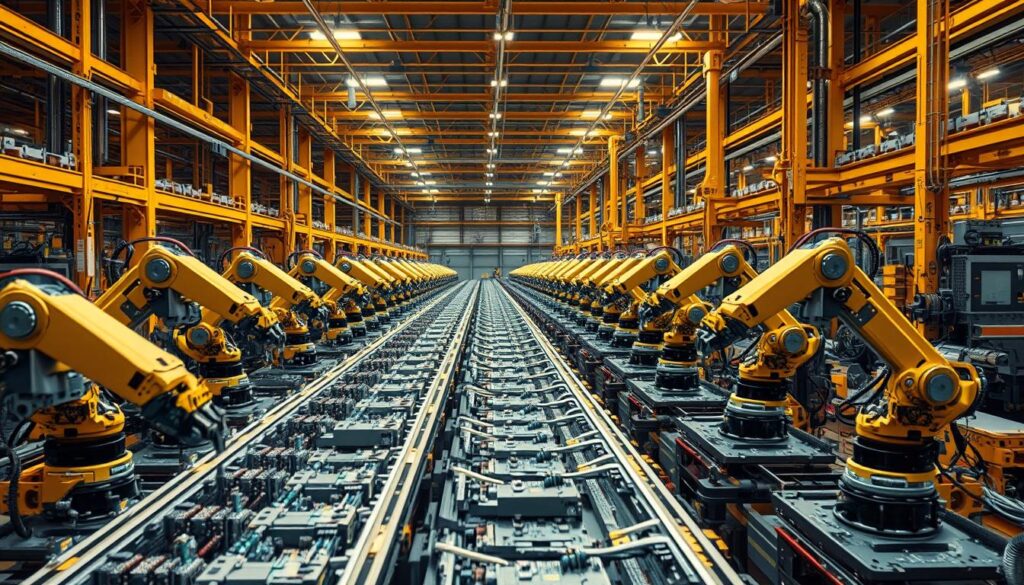“The future belongs to those who prepare for it today.” – Malcolm X. This quote rings especially true in the context of artificial intelligence and its transformative role in shaping economies worldwide. China’s rapid advancements in this field are creating ripples across global markets, sparking both optimism and concern.
China’s commitment to artificial intelligence is evident in its $1.4 trillion investment plan for high-tech industries, including AI, over five years1. This aggressive push has positioned the country as a leader in AI adoption, with 83% of Chinese industries using generative AI, compared to 65% in the United States1. Such disparities highlight the unique dynamics of China’s labor market and its focus on physical jobs, setting it apart from Western economies.
The potential for AI to boost GDP is significant. Estimates suggest it could add $600 billion annually to China’s economy by 20302. This growth is driven by over 4,500 AI companies operating in the country, representing 15% of the global total2. However, challenges remain, including regulatory hurdles and technological competition with the U.S.
This article explores the interplay between technological innovation, market dynamics, and economic transformation. It delves into sector-specific impacts, investment trends, and the strategic importance of research in understanding these shifts. By examining recent data and expert insights, we aim to provide a comprehensive view of China’s AI-driven economic trajectory.
Key Takeaways
- China’s $1.4 trillion investment in AI and high-tech industries underscores its commitment to technological leadership1.
- Generative AI adoption in China outpaces the U.S., with 83% of industries utilizing it1.
- AI could contribute $600 billion annually to China’s economy by 20302.
- Over 4,500 AI companies in China represent 15% of the global market2.
- Regulatory and technological competition with the U.S. poses challenges for China’s AI ambitions.
China’s Rapid AI Transformation in the Global Marketplace

China’s rapid strides in technology are reshaping global industries. The country has become a hub for innovation, with a focus on integrating advanced systems into core business processes. This transformation is driven by significant investments in research and development, positioning China as a leader in the global marketplace3.
One of the most notable achievements is the surge in AI patent filings. In 2020, China ranked first globally for AI-related patents and research papers3. This demonstrates the country’s commitment to pushing the boundaries of technology and securing its place as a global innovator.
Major tech companies like Alibaba and ByteDance are at the forefront of this movement. They are leveraging personalized AI-driven applications to enhance user experiences and expand their market reach. For instance, ByteDance’s mobile chatbot surpassed OpenAI’s ChatGPT in downloads shortly after its launch3.
Technological Innovation and Expansion
Breakthroughs in technology are fueling China’s competitive edge. The core AI industry’s value reached RMB 508 billion (approximately US$75 billion) in 2022, marking an 18% year-on-year increase3. This growth is supported by over 4,300 companies contributing to the AI ecosystem3.
Rapid market expansion in generative AI is another key driver. Shenzhen, Beijing, and Shanghai are leading the upstream AI market, showcasing the country’s ability to scale innovation across regions3. This expansion is not only boosting domestic industries but also influencing international markets.
Influence on Economic Growth and Development
The intersection of technology and industry is accelerating economic development. Goldman Sachs forecasts that advancements in Chinese AI could boost corporate earnings by 2% and increase valuations by 20%3. This highlights the transformative potential of innovation in driving economic growth.
China’s focus on AI applications in public safety and other sectors further underscores its strategic approach to development. For example, the 2017 AI plan emphasizes expanding intelligence-based monitoring systems3. This aligns with broader industry trends and sets the stage for future advancements.
To learn more about how technology is shaping financial landscapes, visit AI in Finance.
How Will China’s AI Impact the Global Economy?

Economic forecasts highlight the transformative potential of technological advancements in reshaping GDP growth. Goldman Sachs Research predicts an 8% uplift in China’s GDP over the next decade, driven by widespread adoption of innovative systems1. This projection, though slightly moderated from earlier estimates, underscores the significant economic impact of these advancements.
Detailed analysis reveals that cost reductions and productivity enhancements are key drivers of this growth. For instance, Baidu’s Qianfan platform reduces training costs by up to 90%, making advanced technologies more accessible2. Such efficiencies are expected to accelerate adoption across industries, particularly in sectors prone to automation.
However, uncertainties remain. The fast-evolving technological landscape makes precise estimates challenging. Factors like adoption rates and cost structures will play a critical role in determining the actual economic impact4. For a deeper dive into these trends, explore our executive briefing on generative AI.
In summary, while optimistic short-term effects are evident, long-term outcomes will depend on sustained innovation and strategic investments. The interplay between technological adoption and economic growth continues to shape future market adjustments.
Investment Trends and Government Policies Driving AI Growth

Investment in advanced technologies is reshaping China’s economic landscape, driven by both private and public sector contributions. Capital expenditure in the tech ecosystem is surging, with a focus on infrastructure like semiconductors and cloud services. By 2025, spending in this area is expected to rise by 38%, reflecting a strong commitment to innovation5.
Increased Capital Expenditure Across Sectors
Leading Chinese model developers are projected to significantly increase their spending. Equity analysts report that investments in AI-related infrastructure are growing rapidly, with over 1,944 companies actively contributing to the ecosystem5. This trend is supported by a $1.4 trillion investment plan unveiled in 2020, which aims to accelerate growth in high-tech industries5.
Service-related innovations are also benefiting from this surge. Cloud computing and semiconductor advancements are key areas of focus, ensuring that the tech ecosystem remains competitive on a global scale5.
Regulation and Policy Support
Government policies play a crucial role in fostering growth. Targeted regulations are designed to support rapid expansion and local market dominance. For instance, 16 local governments are providing subsidies for AI chip purchases, encouraging further investment5.
Policy initiatives have also enhanced private and public sector collaboration. Between 2000 and 2023, government VC funds invested $184 billion in over 9,623 unique firms, highlighting the scale of support5. These efforts are shaping current market trends and driving measurable outcomes.
To explore how these trends are influencing financial strategies, visit AI in Finance.
Sector-Specific Impacts: Manufacturing, Healthcare, and Beyond

Innovations in technology are reshaping key industries, driving efficiency and growth across sectors. From production lines to healthcare systems, advanced systems are creating new opportunities and challenges.
Transformations in Manufacturing and Enterprise Software
Manufacturing processes are undergoing significant changes. Companies are leveraging advanced systems to improve precision and reduce costs. For example, autonomous driving technologies are expected to achieve a 56% penetration rate by 2030, enhancing production efficiency6.
Enterprise software powered by advanced algorithms is reshaping traditional practices. Firms are adopting solutions that streamline employee management and operational workflows. This shift is driving measurable outcomes, with over 4,300 companies contributing to the ecosystem6.
Case studies from leading companies highlight these transformations. For instance, Baidu’s Qianfan platform reduces training costs by up to 90%, making advanced technologies more accessible. Such innovations are setting new benchmarks in the industry.
Advancements in Healthcare and Life Sciences
Healthcare is another sector experiencing rapid advancements. Systems like CardioMind, which started trial runs in Shanghai, are improving diagnostic accuracy and reducing strain on healthcare resources7.
Drug discovery is being expedited through advanced algorithms. The first drug discovered using generative algorithms entered clinical trials in 2023, developed in less than 18 months at a cost of under $3 million7. This is a significant reduction compared to traditional methods.
The market for medical imaging solutions is also growing, expected to reach ¥44.2 billion in 20237. These advancements are improving patient outcomes and creating new economic opportunities.
As these technologies evolve, they are setting the stage for future growth and competitive advantage across industries.
Labor Market Shifts and Automation Challenges
The integration of advanced systems into labor markets is reshaping productivity and employment dynamics. Task automation is driving significant efficiency gains across industries, but it also poses challenges for workers and businesses alike.
Automation is expected to boost productivity by streamlining routine tasks, allowing firms to focus on higher-value activities. For example, in new energy vehicle manufacturing, 90% of polishing work has been automated, with remaining tasks requiring manual completion8. This shift highlights the balance between efficiency and human involvement.
Task Automation and Productivity Gains
Automation is transforming how businesses operate. Research shows that the application of automated robots in manufacturing has a positive impact on employment in China, while in the U.S., it has led to job losses8. This contrast underscores the importance of context in understanding automation’s effects.
Productivity gains are evident, but challenges remain. A report estimated that advanced systems could displace 26% of jobs in China over the next two decades, while creating 90 million new roles9. This transition requires careful planning to mitigate risks and ensure equitable benefits.
- Automation drives efficiency but may disrupt traditional job roles.
- Businesses must adapt to evolving labor market dynamics.
- Policymakers play a crucial role in managing these shifts.
Efforts to address these challenges are ongoing. For instance, training programs in the UK, Greece, and Cyprus have reduced gender and ethnic digital divides, boosting empowerment in the labor market10. Such initiatives highlight the importance of upskilling workers.
To learn more about how automation is redefining productivity, visit AI and Robotics.
Global Competitiveness and U.S. Response to China’s AI Advances
The race for technological dominance between the U.S. and China is intensifying, with both countries leveraging their unique strengths to gain a competitive edge. While the U.S. leads in innovation and private sector investment, China’s rapid adoption of advanced systems is reshaping global dynamics11.
Comparative Analysis of U.S. and Chinese Labor Markets
Structural differences in labor markets play a significant role in shaping competitiveness. The U.S. focuses on high-skilled roles, while China emphasizes physical jobs and large-scale automation. For instance, 83% of Chinese industry leaders use generative AI, compared to lower rates in the U.S11..
This divergence affects how each country integrates advanced systems. China’s labor market supports rapid adoption, while the U.S. prioritizes innovation in specialized sectors11.
Impact on International Trade and Regulatory Reactions
China’s rapid advancements are influencing international trade patterns. The U.S. has responded with stringent export controls, such as the AI Diffusion Framework and Foundry Due Diligence Rule12. These measures aim to restrict China’s access to critical technologies.
However, China continues to innovate despite these barriers. For example, DeepSeek’s model trained on Nvidia A100 chips exceeded performance expectations, causing a 3.1% drop in the Nasdaq12.
Security and intelligence concerns are also shaping competitive dynamics. Both countries are enacting laws to protect their economic interests, with China replicating key U.S. export control authorities12.
- China’s infrastructural capabilities and process efficiencies provide a competitive advantage11.
- U.S. export controls aim to curb China’s technological advancements but may push allies toward alternative partnerships12.
- Opportunities arising from these shifts are influencing global economic planning and strategic investments11.
To maintain leadership, the U.S. must adapt its policies to foster innovation and collaboration with allies. For more insights, explore America’s AI strategy.
Conclusion
Rapid advancements in innovation are reshaping economic landscapes, with significant implications for global markets. China’s strategic focus on technological development, backed by massive investments, is driving transformative changes across industries13. The scale of this growth is evident in the AI industry’s development index, which exceeds national averages in key regions like Beijing and Shanghai13.
Despite these strides, challenges remain. Labor market shifts and economic deflation pose risks, particularly as automation reshapes traditional roles. However, the enduring power of data and decade-long trends continue to underpin China’s strategy, offering significant opportunity for both domestic and international businesses13.
Comparative analysis highlights the competitive dynamics between China and the U.S., with regulatory responses shaping future trajectories14. As these trends evolve, continued research and strategic planning will be essential to navigate the complexities of this rapidly changing landscape. For more insights, explore major predictions for 2024.
FAQ
What role does China play in the global AI market?
How does AI influence China’s economic growth?
What are the key investment trends in China’s AI sector?
How is AI transforming China’s manufacturing industry?
What impact does China’s AI development have on the global labor market?
How does the U.S. respond to China’s AI advancements?
What are the challenges of AI adoption in China?
How does AI impact international trade and regulations?
Source Links
- China’s AI Surge Could Impact the Global Business Landscape, Experts Say | PYMNTS.com
- China And AI In 2025: What Global Executives Must Know To Stay Ahead
- China’s AI Revolution: The Global Tech Power Shift – The Geopolitics
- Assessing China’s AI development and forecasting its future tech priorities
- How Innovative Is China in AI?
- How AI is shaping industries in China | J.P. Morgan Research
- The Future of Healthcare: How China’s medical industry is adopting AI – CKGSB Knowledge
- A Conversation of AI’s Impact on Chinese Labor Market
- Deep Dive: China shifts to automation, industrial robots to stay competitive
- Artificial intelligence and labor market outcomes
- US-China AI Race: How Cost-Effective Models Are Reshaping Global Competitiveness and Investment Strategies –
- Understanding U.S. Allies’ Current Legal Authority to Implement AI and Semiconductor Export Controls
- The influence of AI on the economic growth of different regions in China – Scientific Reports
- In Developing AI, China Takes the Industrial Route







